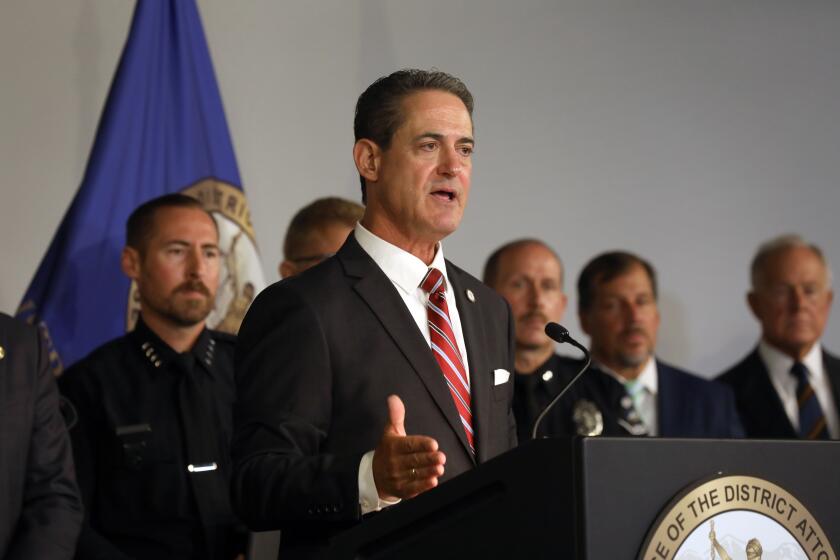40 years since a 5-minute shooting spree caused a lifetime of devastation, Cal State Fullerton remembers 7 lives lost
He slipped through a side door clutching a rifle and descended a flight of stairs to the basement, looking for colleagues he had known for little over a year.
Edward Charles Allaway, a janitor at Cal State Fullerton, stormed into the university’s library, which housed special-purpose activity rooms and offices, going from room to room shooting some people and sparing others.
He chased two custodians, Debbie Paulsen and Donald Karges, down a narrow and windowless hall and shot them.
He fired at Bruce Jacobson after the audio technician hit him on the head with a metal statue.
He gunned down professor emeritus Seth Fessenden and photographer Paul F. Herzberg before taking a service elevator to the first of six floors, where he met eyes with a visiting high school student backed against a wall.
He turned toward her but didn’t shoot. Instead, he shot into a graphic arts studio, striking artist Frank Teplansky twice in the back and once in the head.
He shot Stephen Becker, a library assistant and the son of Ernest A. Becker, one of the university’s founders.
Within minutes, the janitor was out of bullets, and he ran from the library toward a car, driving off to a hotel where his wife was employed.
He called police and asked to be picked up.
The tally: the seven people above dead, two others injured.
That fateful summer morning of July 12, 1976, marked the worst mass murder in Orange County until the 2011 fatal shooting of eight people at a Seal Beach hair salon.
Forty years is a long time. Graduating classes have come and gone, and it may be difficult for today’s students to understand how profoundly Allaway’s crime shook the campus, how far the ripples traveled through time and space.
It’s why a few of the victims’ families and Cal State Fullerton are holding a candlelight vigil and memorial July 12, to commemorate the 40th anniversary of the event that left seven university employees dead.
For the people who loved the men and women who died, their deaths remain vivid. So do their lives.
::
Every once in a while, Paul Paulsen will head to his personal library and pull a few shelved college textbooks.
He’ll flip through the literature anthologies and recognize handwritten notes in the margins.
Scribbles. Interpretations. Comments.
The musty pages stir memories when exposed to fresh air.
With a rush of excitement and a pang of dread, he’ll recognize the bookowner’s cursive.
Debbie. His older sister. One of the first victims killed.
“I can hear her voice saying those things,” Paulsen said. “It’s like she’s living in those notes.”
There, in his Anaheim home, less than four miles from the university, she flickers back to life.
Debbie was Paul’s mentor, or “spirit guide,” as he called her. The 26-year-old graduate student in English literature wanted to be a professor. When she was excited about a subject, her brother recalled, she would communicate it well with others, who in turn would be excited.
Debbie always included Paul when she hung out with friends. She played guitar, loved Judy Collins and Joni Mitchell and was very much a product of the 1960s.
So much youth and beauty, so much kindness and fun.
For the past few years, Paulsen, a friendly man of 64, has searched for a way to honor exactly those aspects of his sister and her colleagues, a way that would emphasize not how they died but how they lived, that would focus on them more than on their killer.
“A memorial is as much for the living as it is for the deceased,” Paulsen said. “It’s a bonding experience for the victims’ families and the community to come together and honor those who lost their lives, and it’s also to remind people that this tragedy can strike at any other time. It’s a continual healing process.”
A memorial is as much for the living as it is for the deceased ... It’s a continual healing process.
— Paul Paulsen
A few days before he died, Frank Teplansky called his only daughter and talked about how he was looking forward to her spaghetti dinner.
He added one more thing.
“Patsy,” he told her, “if something happens to me, you and your brothers are well taken care of.”
Patricia Almazan would never hear his voice again.
By the time she got to the hospital, her father was unconscious.
“He looked so peaceful and serene. He grabbed my hand and started squeezing it,” said Almazan, 70. “I felt like my dad waited for me.”
Teplansky brought his sense of humor and talent for making friends to the campus media center, where he worked as a graphic artist for 11 years.
He was a phenomenally gifted pianist, caricaturist and magician who would pull a quarter out of his unsuspecting children’s ears, his daughter said.
Teplansky spent 20 years in the Marine Corps and served during the Korean War. He was kind to his co-worker, Allaway, who was also an ex-Marine.
Debbie too was friendly with the person who would become her killer.
“My sister’s mistake was that she befriended the shooter,” said Paulsen, who refuses to utter Allaway’s name. “She was a very compassionate person who loved everybody. When she saw someone in need, she tried to help. In this case her motives were misinterpreted.”
After Allaway stormed into the library at Cal State Fullerton and launched into his five-minute rampage, many people believed he should pay with his life, but an Orange County Superior Court judge instead ruled that the killer was insane and therefore not responsible for his actions, and he was committed to a mental institution.
Allaway had been in the maximum security facilities of Atascadero State Hospital before being transferred to the minimal security Patton State Hospital in San Bernardino, where he currently resides.
Because he is a mental patient and not a prisoner, Allaway is eligible to apply for release every year. Being released would allow him to participate in an outpatient program and live in a halfway house.
Over the years, Allaway has petitioned to go free, claiming he is no longer a danger to society. At 77, he has lived longer than his oldest victim, Seth Fessenden, who was 72 when he was gunned down.
In 2001, Allaway put in a bid for release, and several psychiatrists testified that he would not pose a risk if he was under state supervision. But Superior Court Judge Frank F. Fasel concluded that doctors had difficulty predicting whether Allaway might kill again, given his long history of schizophrenia, and denied the killer’s request.
Meanwhile, the prospect of seeing the mass murderer gain freedom had prompted an organized movement to block such a move. Orange County Supervisor Todd Spitzer led a group web site and organized a letter-writing campaign and memorial service on the Cal State Fullerton campus.
Paulsen and Almazan said they are particularly grateful for the support they received from Spitzer, Orange County Dist. Atty. Tony Rackauckas and Deputy Dist. Atty. Dan Wagner, who have all worked to keep Allaway locked up.
“Dan challenges everything,” Paulsen said of Wagner, who became involved with the case around 2000. “We’re certainly pleased with how the DA’s office has been handling this case. We’re kept informed, and anything we don’t know, Dan gives us every detail.”
Wagner noted that the murderer has more freedom than most prisoners. He is housed in a dorm-style room in a psychiatric hospital that offers institutional programming, recreation and exercise.
“We don’t think he’s a safe candidate for release,” Wagner said.
Having appeared at past memorials, Wagner plans to speak at this year’s commemoration. He said it is important for him to provide long-term support for the victims’ family members.
“I connected with the victims’ families, and I understand the loss they’ve had in their lives,” he said.
On the morning of the shootings, Paul Miller, the school’s director of handicapped student services, arrived to work late, five to 10 minutes after Allaway had run to his car.
When Miller walked onto the campus, he saw an ambulance and victim Becker being assessed by paramedics. He noticed Becker’s father, Ernie, walking toward the scene and advised him to ride with his son in the ambulance.
Miller had been working at the university for two years, assisting students with disabilities in securing their college degrees. His office was originally in the library, across from the janitor’s workspace, but he had moved before the shooting spree.
He’d occasionally interact with Allaway, usually just casual greetings, but one time Allaway complained to him about wheelchair tires scuffing the library floor.
“You would never guess that he would have potential in inflicting trauma,” Miller said.
In the immediate aftermath of the massacre, campus leaders needed time to process what had happened, and they also found it inadvisable to address the matter publicly until the investigation was concluded, Miller said.
When victims’ families — primarily Paulsen and Almazan, since many others connected to the horror have died or drifted away — reached out to the school this year to host a vigil in honor of those who lost their lives, the university said it was important for the campus to offer support and stand in solidarity with the families, said Christopher Reese, director of government and community relations.
About two years after the shooting, the university planted seven stone pine trees in honor of each victim and listed each person’s name on a plaque for a memorial installed north of the library.
Today, students learn of the memorial during campus tours, and many continue to pass by it daily. The once-quiet location now sees heavy foot traffic because of the construction of university dorms nearby.
It’s a revered place for Paulsen and Almazan. They tend to the memorial, clearing away debris, polishing the plaque and planting roses near their family members’ names beneath the evergreens.
“From my sister’s perspective, she would like that living memorial,” Paulsen said. “It’s very cool and serene, and for us here, it’s peaceful.”
The candlelight vigil will be held from 7 to 8:30 p.m. July 12 at the Memorial Grove at Cal State Fullerton, 800 N. State College Blvd. For more information, call (657) 278-7295 or contact Jeanne Tran at [email protected].
--
Kathleen Luppi, [email protected]
Twitter: @KathleenLuppi
More to Read
Sign up for Essential California
The most important California stories and recommendations in your inbox every morning.
You may occasionally receive promotional content from the Los Angeles Times.











